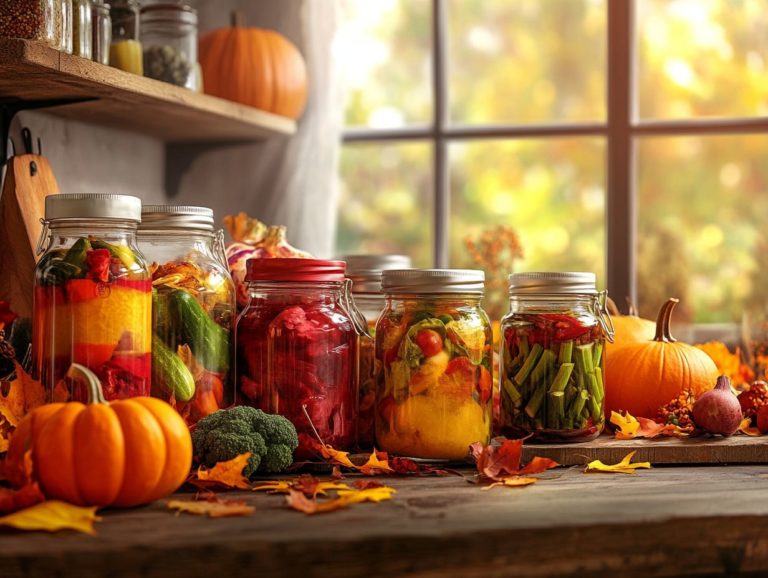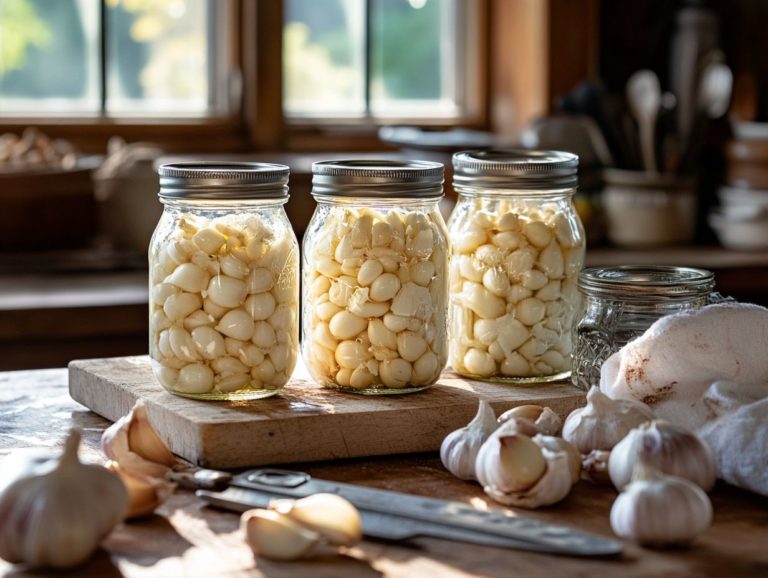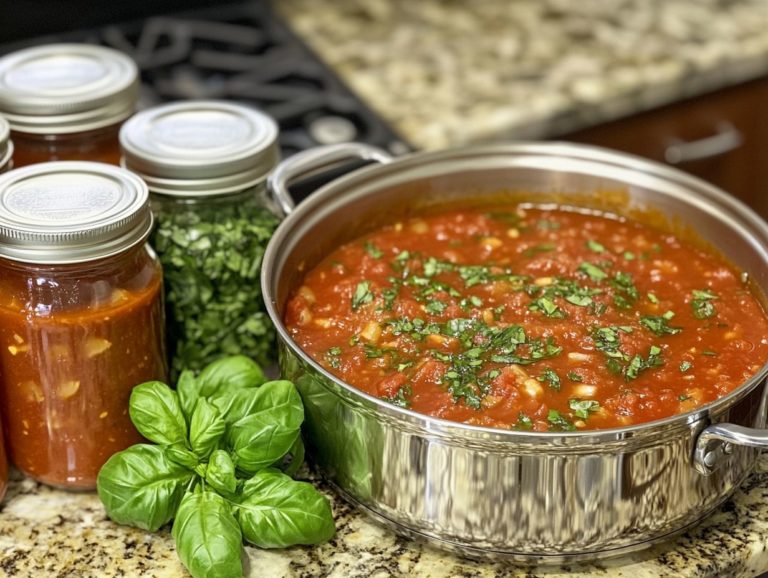5 Essential Recipes for Canning Sauerkraut
Canning sauerkraut is more than just saving cabbage; it’s a fun way to get creative in the kitchen! It offers you a delightful opportunity to explore a spectrum of flavors and elevate your culinary skills, especially when you experiment with various preserving recipes.
This guide also presents five essential recipes, ranging from the classic basic version to vibrant, spicy blends and intriguing combinations like apple and onion. You’ll also find insights on the necessary equipment, health benefits, sauerkraut storage, creative applications, and common pitfalls to avoid.
Whether you’re just starting out or you’re a seasoned canner, there’s something here for everyone to enjoy.
Contents
Key Takeaways:
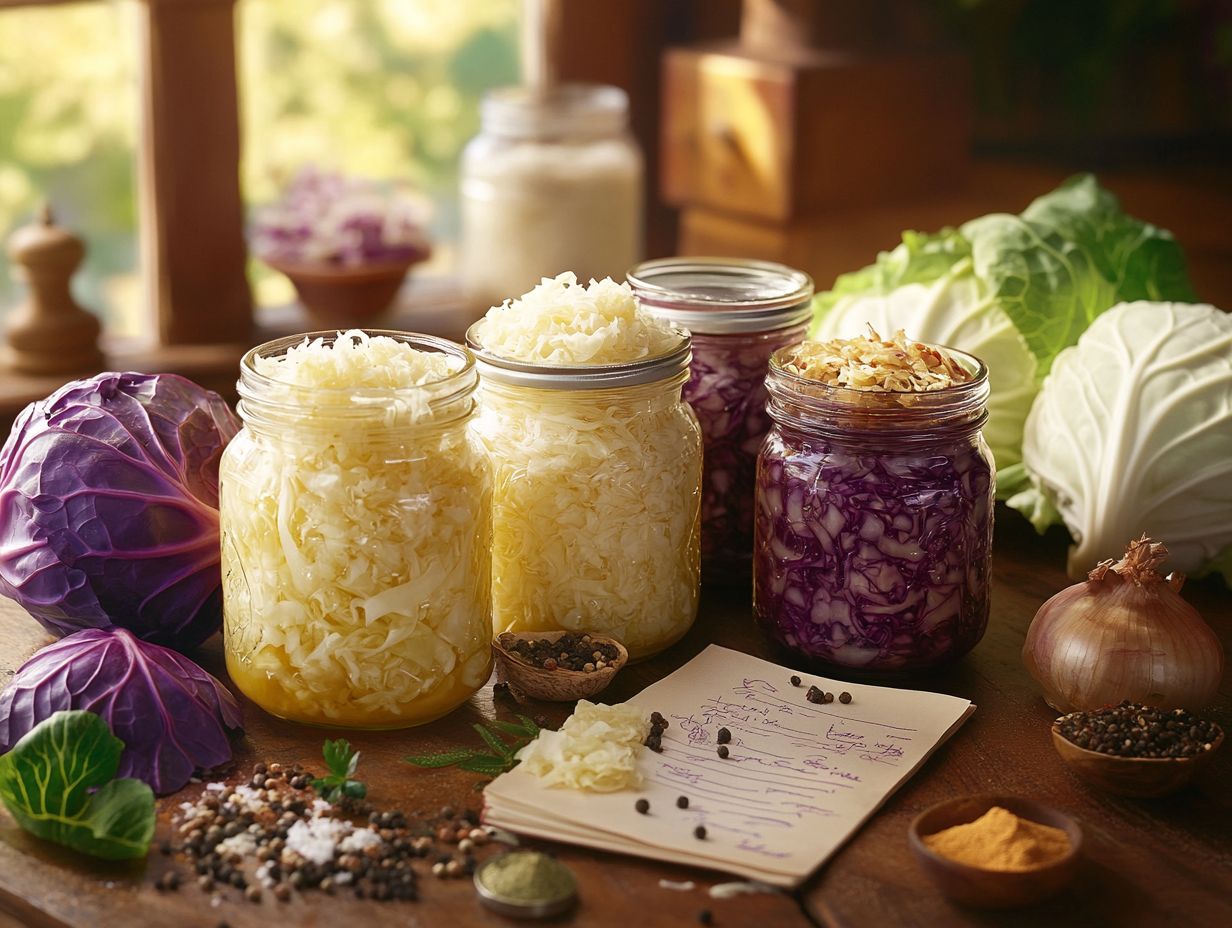
- Experiment with different flavor variations of sauerkraut, such as spicy or garlic and herb, to find your perfect recipe.
- Ensure you have all the necessary equipment before starting the canning process, including canning jars, lids, and a large pot.
- Sauerkraut is not only delicious, but it also has many health benefits, including improved digestion and a boost to the immune system.
1. Basic Sauerkraut Recipe
Making a basic sauerkraut recipe at home is rewarding. You get to savor the tangy flavor of your homemade sauerkraut and explore its health benefits, like probiotics.
Using organic cabbage and kosher salt, you’ll create the ideal brine solution for fermenting the cabbage. To begin, gather fresh organic cabbage green is your best bet for that classic taste along with some fine kosher salt.
The secret is in thinly slicing the cabbage before mixing it with the salt. This step helps release those natural juices that will form your brine. Let this mixture rest for about 30 minutes to enhance the fermentation process and boost the flavor of your brine solution.
Once the cabbage is submerged in its own brine, pack it tightly into a clean fermentation jar. Make sure to eliminate any air pockets; this brine solution is vital as it promotes the growth of beneficial bacteria.
For the best results, store your sauerkraut in a cool, dark place. Be sure to check on it regularly and transfer it to the refrigerator once it reaches your desired level of tanginess. This simple step will help maintain its freshness and flavor, ensuring that every bite is as delightful as the first, whether you enjoy it with pork chops or hot dogs.
2. Spicy Sauerkraut Recipe
If you re seeking to elevate your culinary creations, this Spicy Sauerkraut Recipe seamlessly merges the age-old fermentation process with bold, fiery spices. The result is a delectable homemade sauerkraut that complements a wide array of dishes.
By introducing spices like caraway, coriander, and even a pinch of chili flakes, the fermentation journey takes on an exhilarating new dimension. This transforms humble cabbage into a vibrant flavor explosion. Caraway seeds lend a subtly sweet and earthy aroma, while coriander infuses a citrusy brightness.
For those who enjoy a bit of heat, incorporating crushed red pepper brings the spice without overpowering the other flavors, resulting in a final product that is both complex and perfectly balanced.
Choosing pickling salt guarantees proper fermentation and amplifies the overall spiciness. This allows the unique profiles of your chosen spices to shine in every delightful bite.
With this approach, transforming traditional sauerkraut into an exceptional condiment for sandwiches, bowls, or salads becomes effortlessly achievable.
3. Garlic and Herb Sauerkraut Recipe
This Garlic and Herb Sauerkraut Recipe offers a delightful twist on the classic dish. Every bite is brimming with the health benefits from probiotics of fermentation while seamlessly blending the robust flavors of fresh herbs and garlic.
In this recipe, you ll find varieties of garlic, including mild and aromatic elephant garlic. These are paired with hearty herbs like dill, oregano, and thyme, each contributing unique health benefits. Dill supports digestion, while oregano is celebrated for its anti-inflammatory properties.
Fermentation preserves these ingredients. It also enhances their flavors, resulting in a tangy, crisp condiment that beautifully complements a wide array of dishes.
Get ready to take your savory meals to the next level with this versatile sauerkraut! Whether it s topping a hearty sausage, adding a pop of flavor to creamy potato salad, or enhancing a simple vegetable stir-fry, it s a delightful addition to your cooking skills.
4. Apple and Onion Sauerkraut Recipe

The Apple and Onion Sauerkraut Recipe presents a delightful fusion of sweet and savory flavors. It elevates traditional fermented cabbage while adding a unique twist that is both nutritious and delicious.
By incorporating apples and onions into the fermentation process, you create a harmonious balance of sweetness and depth. The apples introduce a hint of natural sugar, complementing the tangy notes of sauerkraut while nourishing the beneficial bacteria that drive fermentation.
Onions contribute savory richness, amplifying the umami elements as they break down during the process. This combination creates a distinct flavor that can enrich various savory dishes.
Imagine adding this vibrant sauerkraut to tacos, using it as a topping for roasted meats, or mixing it into grain bowls for an extra layer of texture and taste.
5. Caraway and Mustard Seed Sauerkraut Recipe
This Caraway and Mustard Seed Sauerkraut Recipe beautifully blends the traditional flavors of fermented cabbage with the aromatic zest of caraway and mustard seeds. The result is a delicious homemade sauerkraut that tantalizes your taste buds while offering probiotic benefits.
Imagine the earthy, anise-like notes of caraway seeds complementing the tangy crunch of the fermented cabbage. This creates a harmonious dance of flavors that elevates any dish you prepare.
Mustard seeds add a subtle heat and complexity, enhancing the overall experience of this unique condiment. As beneficial bacteria flourish during fermentation, they transform the raw ingredients into a vibrant, probiotic-rich food that supports gut health. Probiotics are beneficial bacteria that support gut health.
This culinary metamorphosis doesn’t just boost digestion; it also introduces a spectrum of vitamins and antioxidants, making each bite flavorful and nourishing for your body.
What Equipment Do You Need for Canning Sauerkraut?
Canning sauerkraut calls for specific equipment to ensure a safe and successful preservation process. You ll need essential items like high-quality jars, fermentation weights, and the right tools for creating a proper brine, all in accordance with USDA guidelines.
First, your jars should be top-notch and properly sterilized. They will house your fermented masterpiece and help prevent contamination. It’s crucial to have fermentation weights to keep the cabbage submerged in brine, ensuring optimal fermentation and flavor enhancement.
A canning pot with a rack maintains the right processing temperature. Handy tools like a jar lifter and funnel make filling and sealing a breeze.
The USDA underscores the importance of adhering to specific safety measures. Use correct processing times and check seals to ensure your final product is safe to enjoy. Finally, accurately preparing the brine by balancing salt and water is vital for flavor and preservation, ensuring your canning endeavor is a success.
What Are the Health Benefits of Sauerkraut?
Sauerkraut is more than just a tasty condiment; it offers an impressive array of health benefits that can elevate your overall wellness. Don t miss out on this culinary gem!
With its remarkable ability to enhance digestion and boost probiotic levels, sauerkraut is a true powerhouse. Packed with vitamins C and K, it fortifies your immune system while promoting radiant skin.
Its generous fiber content plays a key role in regulating bowel movements and can help ease discomfort linked to digestive issues. The fermentation process involves beneficial bacteria that change food, making nutrients easier for your body to absorb.
By adding this zesty dish to your diet, you can improve your gut health. The probiotics in sauerkraut nourish the good bacteria essential for a balanced microbiome. Embracing fermented foods like sauerkraut can elevate your nutritional intake and contribute to a more vibrant lifestyle.
How Long Does Canned Sauerkraut Last?
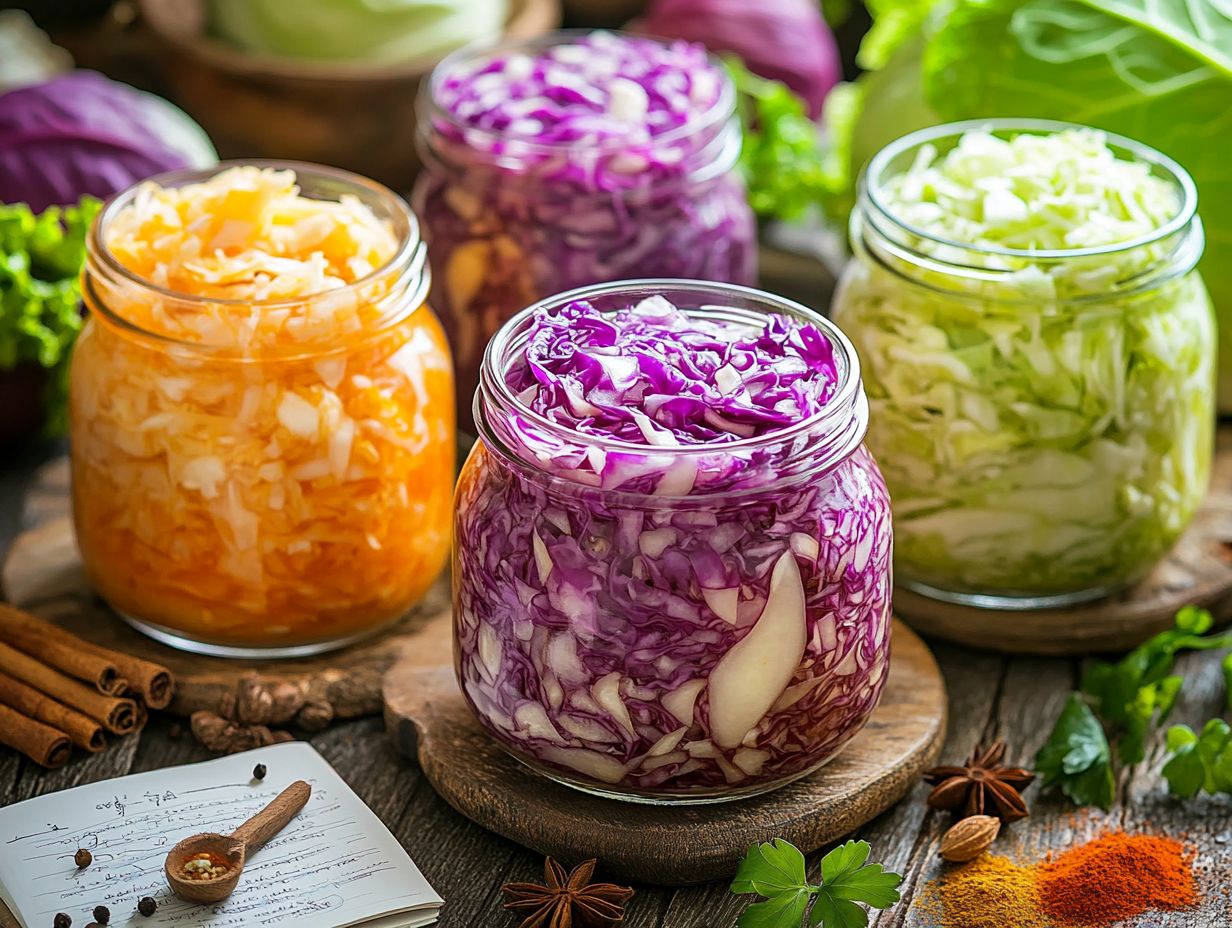
Canned sauerkraut can stay delightful for quite some time when stored properly. You can savor its tangy flavor and health benefits long after the canning process is complete.
Its longevity depends on several factors, including the integrity of the can, the storage environment, and the ingredients used during canning. Ideally, keep sealed cans in a cool, dark pantry, away from temperature fluctuations and humidity, ensuring your homemade sauerkraut lasts for months.
Once you open the can, transfer any unused sauerkraut into a sealed container and place it in the fridge to maintain freshness.
Follow these guidelines to enjoy the distinctive taste of this fermented delight for an extended period while preserving its nutritional value.
What Are Some Creative Ways to Use Canned Sauerkraut?
Canned sauerkraut is a versatile ingredient that you can add to various savory recipes, transforming classic dishes like pork chops and hot dogs into flavorful meals.
But don t stop there! This fermented delight can elevate comfort foods too, such as grilled cheese sandwiches or hearty casseroles. Imagine a creamy potato bake with tangy sauerkraut cutting through the richness, or a robust stew enhanced by its sour notes.
It fits seamlessly into international fare think of a German Reuben sandwich that gains depth or a Polish bigos that receives a zesty kick. Whether you use it as a topping for your favorite burger or as an ingredient in gourmet quiches, the adaptability of sauerkraut means there s always a new culinary adventure waiting for you.
What Are Some Common Mistakes to Avoid When Canning Sauerkraut?
When you embark on the art of canning sauerkraut, be mindful of common mistakes that can lead to disappointing results. These include improper fermentation and overlooking essential tips that ensure both safety and flavor. For inspiration, check out these must-try canning recipes for spring.
Common pitfalls include:
- using unclean equipment
- failing to measure ingredients accurately
- neglecting temperature control during fermentation
It’s crucial to follow recommended guidelines for canning. These protocols, such as canning cabbage, elevate the taste and texture of your sauerkraut and significantly minimize the risk of spoilage or foodborne illness.
By consistently monitoring the fermentation process, checking pH levels, and ensuring proper storage conditions, you can achieve a successful batch that is both delicious and safe. Ignoring these practices might lead to easily avoidable issues with just a touch of care and knowledge.
Try incorporating sauerkraut into your meals today!
How Can You Tell If Your Canned Sauerkraut Has Gone Bad?
Recognizing when your canned sauerkraut has gone bad is crucial for ensuring that your food is safe to eat. There are several signs to watch for that indicate spoilage or fermentation issues.
First, take a moment to examine the color. If it shifts to a dull or dark shade, it s a clear sign that the contents may no longer be fresh. A sour or unpleasant smell, rather than the tangy aroma you expect, should raise a red flag.
Texture is also important. If the sauerkraut feels excessively mushy or slimy, it s wise to err on the side of caution.
To prevent spoilage, always store your canned sauerkraut in a cool, dry place, and ensure the lid is tightly sealed after opening. Check expiration dates regularly to maintain quality.
Watch this video to learn about canning sauerkraut step by step.
Frequently Asked Questions
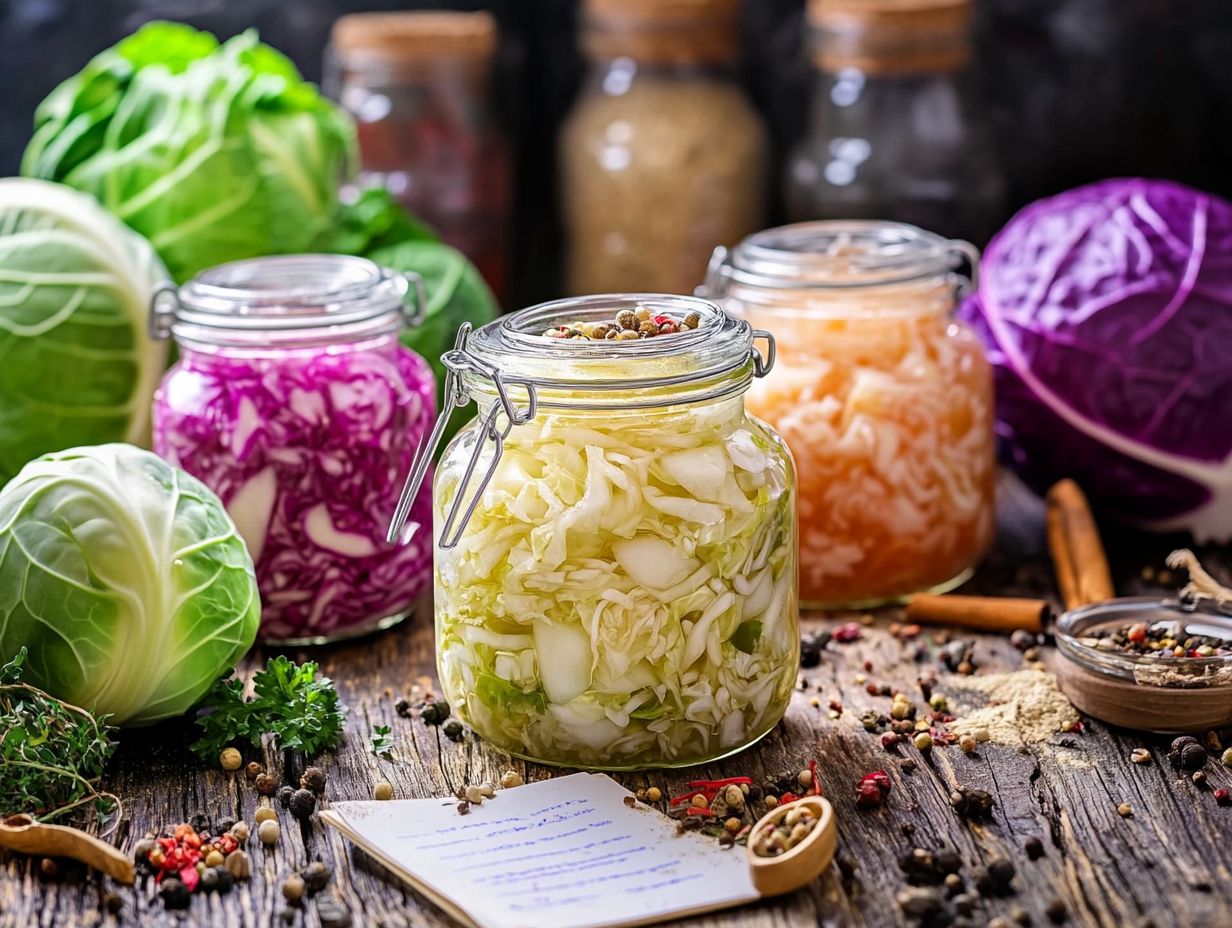
-
What are the essential recipes for canning sauerkraut?
Discover the joy of canning your own sauerkraut with these simple recipes: traditional sauerkraut, dill sauerkraut, spicy sauerkraut, apple sauerkraut, and caraway sauerkraut. For even more inspiration, check out these must-have canning recipes for your kitchen. These recipes can be fine-tuned to suit individual tastes, ensuring that your cabbage is always fresh and delicious.
-
What equipment do I need to can sauerkraut at home?
You will need a large pot or canner, glass jars with lids, tongs, a canning funnel, and a ladle to properly can sauerkraut at home.
-
How do I make traditional sauerkraut for canning?
To make traditional sauerkraut for canning, you need shredded cabbage, salt, and a large pot or canner. For the best results, consider using 5 must-have ingredients for home canning. Simply mix the shredded cabbage with salt, pack it tightly into jars, and process them in a boiling water bath for 15 minutes.
-
Can I add different flavors to my sauerkraut when canning?
Yes, you can customize your sauerkraut by adding different flavors such as dill, spices, apples, or even caraway seeds. Experiment with different flavors to find your favorite combination.
-
Is it safe to can sauerkraut at home?
As long as you follow proper canning techniques and use the correct equipment, it is safe to can sauerkraut at home. Make sure to properly sterilize your jars and process them in a boiling water bath for the recommended time.
-
How long can I store canned sauerkraut?
If properly canned and stored in a cool, dark place, canned sauerkraut can last for up to a year. Once opened, it should be stored in the refrigerator and consumed within a few weeks.

